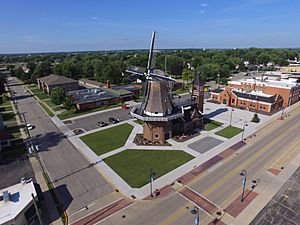Little Chute Windmill facts for kids
Quick facts for kids Little Chute Windmill |
|
|---|---|
 |
|
| Origin | |
| Mill name | Little Chute Windmill |
| Mill location | Little Chute, Wisconsin |
| Coordinates | 44°16′49″N 88°19′00″W / 44.280204°N 88.316805°W |
| Information | |
| Type | Smock mill |
| Storeys | Three-story smock |
| Base storeys | Three-story base |
| Smock sides | Eight sides |
| No. of sails | Four sails |
| Type of sails | Common sails |
| Winding | Tailpole and winch |
The Little Chute Windmill is a real Dutch windmill located in Little Chute, Wisconsin, USA. It's a special building that shows off the Dutch history of the area. This amazing wooden windmill actually works! It uses wind power to grind grain into flour, just like windmills did long ago.
When you visit, you can take a tour to see how the windmill operates. You'll learn how it uses wind to turn big grinding stones. The windmill is found at 130 West Main Street in Little Chute. It usually runs during the warmer summer months. The visitor center next to it is open all year, except on Sundays.
Contents
Discover the Little Chute Windmill
The Little Chute Windmill is designed like a real 1850s Dutch windmill. Its style comes from the North Brabant province in the Netherlands. Many of the first Dutch settlers in this area came from there.
This tall wooden windmill stands about 38 meters (125 feet) high. It was designed by Lucas Verbij, whose family has built windmills for generations. Parts of the windmill were built in the Netherlands. Then, they were shipped to Little Chute to be put together.
What is a Smock Mill?
The Little Chute Windmill is a type called a "smock mill." Imagine a person wearing a smock, which is a loose outer garment. A smock mill looks a bit like that! It has a wide base that gets narrower as it goes up. The top part, called the "cap," can turn to face the wind. This allows the sails to catch the most wind power.
How Windmills Work
Windmills like this one use the power of the wind to do work. The large sails catch the wind, which makes them spin. This spinning motion turns a big shaft inside the windmill. The shaft then connects to gears and other machinery. This machinery powers large grinding stones. As the stones turn, they crush grain into flour. It's a clever way to use nature's power!
Explore the Van Asten Visitor Center
Right next to the windmill is the Van Asten Visitor Center. This center has many displays about the history of Dutch settlers in Little Chute. You can learn how they came to the area and built their new lives.
The Little Chute Historical Society manages the displays here. They also keep old records, family history information, and research materials. There's even a special room called the Van Dyn Hoven Media Room. This room can be rented for events. It often shows photos and videos of how the windmill was built.


